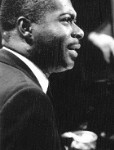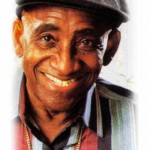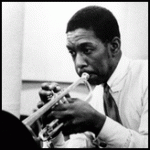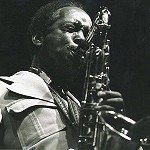From 1965-1985 one of the New York metro area’s hotspots for live jazz was the Blue Coronet in Brooklyn – the Bedford-Stuyvesant community to be exact. Sometimes I wonder if perhaps Brooklyn should be labeled the Second City instead of Chicago, given the backseat that storied borough so often takes to its little sister Manhattan (Brooklyn being by far the bigger land mass). Case in point, while surfing the web in search of additional background on the Blue Coronet, consistently the only listing that shows up in a Google search is reference to a bootleg recording made there in 1969, about which more in a minute. The New Grove Dictionary of Jazz has a generally reliable series of pages under its Nightclubs entry that provides handy thumbnail sketches of various and sundry jazz clubs around the country, in major cities as well as smaller burghs… except for Brooklyn, where none of the borough’s jazz clubs are mentioned. And this is despite the fact that during a period in the 50s and 60s Brooklyn was alive with jazz clubs, particularly in the Bed-Stuy, an area that was home to a significant number of great jazz masters, including Eubie Blake, Max Roach, Randy Weston and Cecil Payne, and also including a certain trumpet player who spent many nights at the Blue Coronet and who as a younger man had lived in Bed-Stuy with the mother of his first child.
That Brooklyn disparity is one reason we’ve embarked on a research project of discovery into jazz in Bed-Stuy, essentially Central Brooklyn, for the Weeksville Heritage Center. In recent months The Independent Ear has excerpted lively interviews with some of the principles behind such legendary Brooklyn jazz venues as the East, and the current bastion known as Sista’s Place. However one joint preceded both of those homes to the music; the Blue Coronet has consistently been mentioned by both musicians, activists and fans alike as a home of great sounds. So we sought out Dickie Habersham-Bey, the owner-proprietor of the now-shuttered Blue Coronet. Though somewhat frail of health recently, Mr. Habersham-Bey gave some lively commentary on the Blue Coronet, including shedding some light on one of the more notorious nights in Miles Davis‘ storied odyssey. Read on…
Willard Jenkins: How did you come to own The Blue Coronet?
Dickie Habersham-Bey: The [original] Coronet closed down in 1965, it was in the same building at 1200 Fulton Street. I bought it about ’66 and opened it as The Blue Coronet. The first musician I opened up with was [pianist] Wynton Kelly, with Jimmy Cobb on drums and Paul Chambers on bass.

The Wynton Kelly Trio, one of Miles’ greatest rhythm sections, was an early staple at the Blue Coronet; Wynton actually lived in the neighborhood.
WJ: When you were hiring musicians at that time, how long was their typical run at the club?
HB: When I hired Wynton Kelly that was for two weeks. My grand opening, in 1967, was Max Roach with Abbey Lincoln, Charles Tolliver on trumpet… I forget who else he had, he had a dynamite group. Then I started booking musicians for a week, and every week I had a different musician for 15 years. The week would begin on Tuesday and last until Sunday, they played three sets a night starting about 8:00 and ending about 3 or 4am.
WJ: What were the audiences like when you first opened?
HB: Very accepting. When I first opened up it was a big thing.
WJ: How was it in terms of steady business?
HB: With jazz [the audience] is not real big money spenders – at least not at that time – so I had to charge a door price, which kept a lot of riff-raff away because at the time there was a big drug problem going around. One of the reasons why the original proprietors [of the Coronet] closed up is because there were a lot of drugs in the area and I scrutinized whoever came in.
WJ: And how would you scrutinize them?
HB: By charging at the door. At the time it was $2 during the week, $5 on weekends.
WJ: What was the capacity of the Blue Coronet?
HB: The capacity was small… about 100… with 150 people it was packed.
WJ: That was 150 sitting at tables?
HB: No, about 100 sitting at tables, the rest sitting at the bar or standing up.
WJ: Describe the Blue Coronet physical space.
HB: When you came in there was a foyer, a standing room that amounted to about 10 feet before you got to the bar. To the right was the bar, which was about 35-40 feet long and held about 18-19 stools and then you had the standing room, then you had the back. It was open and you could see the stage anyplace in the bar. The stage set up around 5-feet [high]. And I opened up a [new] kitchen [from the former Coronet]. I did maybe $100,000 [renovation] job on it.
WJ: So there were good sightlines throughout the place?
HB: Yes, that’s a good way to put it.
WJ: On an average week you would present someone from Tuesday-Sunday. What were your biggest nights?
HB: Our biggest nights were of course Friday & Saturday, and if we had a good act Thursday as well.
WJ: Who were some of the more successful people who played your club in terms of your audience?
HB: To tell you the truth, the bigger act at that time, the heavy jazz boys: of course Miles [Davis], Max [Roach], [Thelonious] Monk… those would get you crowds. We had a lotta local Brooklyn boys, seemed like everybody in the world came out of Brooklyn… maybe because of cheaper living, but we had our crowd [of musicians] come out of Brooklyn: Kenny Dorham… I could go all down the line; but you get what you pay for. I remember every New Year for a long time we used to have double acts, for New Year’s Eve I would have like Freddie Hubbard and his quintet and Lee Morgan and his quintet… a battle of the trumpets. We had a lotta repeats: Mongo Santamaria…, I’ve got lists of names… but everybody you could name, you name ‘em they played there, every jazz musician of note: Hugh Masakela… you name ‘em, big and small.

Master conguero-bandleader Mongo Santamaria brought Afro-Cubana to the Blue Coronet.
WJ: Was your audience an all-black audience?
HB: It was 95% black. You gotta remember, the Village was going strong then – the Village Gate, Village Vanguard… and I was doing just as much as they were doing. I had a few singers, but mostly instrumentalists.
WJ: What singers did you present?
HB: Local singers… No real big singers, mostly local. Abbey Lincoln came in with Max, Etta Jones played there many, many times with Houston Person.
Brooklyn had the biggest conglomeration of jazz musicians living there… Randy Weston did a lot of shows for me, Kenny Dorham, Cecil Payne all the time… [Laughs] You name ‘em, they played…

Kenny Dorham was another of the greats who lived in Brooklyn and played the Blue Coronet.
WJ: Did you have other places at the time?
HB: 1985 – twenty years… or better. I had four other bars at the time, all in Brooklyn – Dickie’s Monterey; the New World on Flatbush Avenue; the Uptown Lounge on Sterling Street… I had my brother working with me too.
WJ: Did you maintain the same policy at the Blue Coronet for all that time?
HB: Sure… One of the reasons I did cut out, or left it alone, was because it wasn’t attractive anymore, we had a drought… and I couldn’t maintain it.
WJ: When did the drought begin?
HB: After about 25 years. There were a number of things, big drugs in the neighborhood, high unemployment, lack of concern for jazz fractured the musicians… all those factors. Sonny Stitt used to be my very good friend, and it got to a point where I payed him $1500-1600 a week, which was not too bad for a small place, I could live with that… I would give him a week there and a week at Count Basie’s [club]. Miles Davis, I would pay him $5,000 a week – but look who he came with! A lotta guys would play the club and the [musicians] union would supply them with local [rhythm sections], but Miles came in with Herbie Hancock, Ron Carter, Wayne Shorter, Tony Williams… so when he came in he had his regular group.

The Miles Davis Quintet recording “Complete live at the Blue Coronet 1969” is the only known live recording made at the club; this widely available bootleg featured the band that followed the disbanding of Miles’ second great quintet, with Wayne Shorter as the lone holdover, joined by Chick Corea on electric piano, Dave Holland on bass, and Jack DeJohnette on drums. Buyer beware: the poor-to-mediocre sound quality of this 2-CD set – likely recorded surreptitiously from underneath some patron’s table or trench coat pocket makes it purely for Miles Davis completists.
The Night Miles Davis was shot…
WJ: Speaking of Miles, there’s the famous story of his being shot after a Blue Coronet engagement.
HB: [Chuckles] There’s always been guys that want to take over the business when they see you doing good business. The week I had Miles… he was working for me regularly; anytime he had a week off he would call and say ‘hey Dick, I’ll bring [the band] in. This guy who was monopolizing the business – he’s dead now, he got shot on Flatbush Avenue… the name is not important. I booked Miles that week [the week Miles was shot in an altercation in Manhattan after a gig at The Blue Coronet], the Village Gate had Gloria Lynne. Now he made a deal with me to have Gloria Lynne at my place, I told him I couldn’t, so he told Miles ‘don’t show up’ [at The Blue Coronet]; certain people tried to bulldoze musicians at that time.
I looked in the paper and it said Gloria Lynne was gonna be at the Village Gate. This guy said ‘no, Gloria Lynne gonna be at your place…’ There were some threats passed and Miles lawyer – Harold Lovette… that bastard [laughs] knew there was tension. Harold called [this guy] and told him what to kiss… See Harold started everything. They weren’t consulting me because I knew Miles was going to be at my place, and not Gloria Lynne. Then Harold told that guy what to kiss and said Miles was coming over [to the Blue Coronet] anyway. So over Harold’s BS, this guy wanted to make a point, to show you how bad he was.
When Miles played I had to keep two parking spaces out front of the Blue Coronet to keep Miles and his red Ferarri out front because there were no designated parking spaces. So when Miles left the club they put the boys on him. You know in Brooklyn it’s very easy to get shooters, even at that time, and they drove up and shot Miles’ car up. When I went down to see the car, if Miles hadn’t had that heavy [car] door, he would have been dead. They arrested Miles for having a couple of reefers on him. Miles said he was never coming to Brooklyn again.
WJ: Were you there that night, and how did you find out what had happened?
HB: In the papers, on the radio. They shot him in Lower Manhattan after he left the club [date: October 9, 1969]; they followed him to Manhattan. Right after that Miles started playing that off-beat [electric] jazz.
WJ: Did you have any kind of stylistic policy in terms of who you brought into the club?
HB: Not really, I didn’t have any real… I wasn’t opinionated about the type of music they played. Avant garde stuff like Randy [Weston] plays… Randy would get on that piano and play two months… I love Randy, that’s my man, but somewhat avant garde. Another one was McCoy Tyner, the same way…
WJ: What makes you refer to your place as a community place?
HB: It was all black for one – the Coronet had a white owner – I made the Blue Coronet a black atmosphere; I gave all the locals a shot, I gave everybody a shot.
WJ: How would you compare your policy at The Blue Coronet with the policy of other clubs in Brooklyn at the time?
HB: They didn’t have many. They had Town Hill at the time; that was a variety place, mine was strictly jazz. They had Sam Cooke up there, Dinah Washington… and that was a huge place, mostly singers. Turbo Village was just live music at the time; no one compared with what I was doing at the time.
WJ: So your place from 1965-1985 was, at least in your estimation, THE jazz club in Brooklyn.
HB: Right.
WJ: Was your audience strictly Brooklynites, or did people come over from Manhattan and other places?
HB: I never took no census, but I advertised in the New York Times, the Post, the Daily News… advertising was a big part of it… I did radio [advertising]; a good part of my money went out for advertising, posters… mostly in Brooklyn. I advertised in the Amsterdam News… I got my play in the newspapers; when they [listed] jazz spots, the Blue Coronet was there. I got a big picture in the Daily News, me and Sonny Stitt… They gave me my play… I advertised every week.

Sonny Stitt was a Blue Coronet regular and personal friend of owner Habersham-Bey.
WJ: Did you have MCs at the Blue Coronet?
HB: Yeah, we had Irvin C. Watson… he was from Brooklyn, he was a friend. And Jimmy Morton.
WJ: Were you on good terms with the musicians?
HB: Yeah, very good terms, ‘cause I was a fair guy and I knew how hard it is being a black musician, especially a jazz musician. I was discriminating about what I wanted in the club; if it was going to be a jazz club, be a jazz club.

Pingback: Interview with Roy McCurdy by Scott K Fish Pt. 2 | Scott K Fish
Pingback: Kind of Clichéd: How the Miles Davis Movie Could Have Been Better – The New Yorker | Movie Update